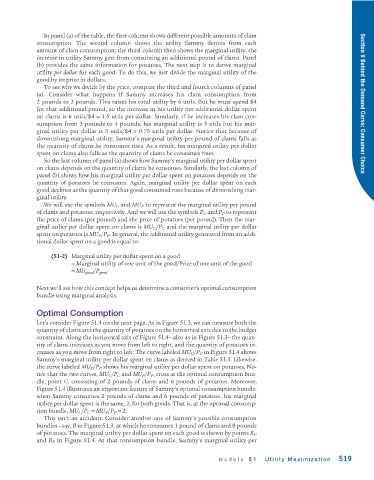Page 561 - Krugmans Economics for AP Text Book_Neat
P. 561
In panel (a) of the table, the first column shows different possible amounts of clam
consumption. The second column shows the utility Sammy derives from each
amount of clam consumption; the third column then shows the marginal utility, the
increase in utility Sammy gets from consuming an additional pound of clams. Panel
(b) provides the same information for potatoes. The next step is to derive marginal
utility per dollar for each good. To do this, we just divide the marginal utility of the
good by its price in dollars.
To see why we divide by the price, compare the third and fourth columns of panel
(a). Consider what happens if Sammy increases his clam consumption from
2 pounds to 3 pounds. This raises his total utility by 6 utils. But he must spend $4 Section 9 Behind the Demand Curve: Consumer Choice
for that additional pound, so the increase in his utility per additional dollar spent
on clams is 6 utils/$4 = 1.5 utils per dollar. Similarly, if he increases his clam con-
sumption from 3 pounds to 4 pounds, his marginal utility is 3 utils but his mar-
ginal utility per dollar is 3 utils/$4 = 0.75 utils per dollar. Notice that because of
diminishing marginal utility, Sammy’s marginal utility per pound of clams falls as
the quantity of clams he consumes rises. As a result, his marginal utility per dollar
spent on clams also falls as the quantity of clams he consumes rises.
So the last column of panel (a) shows how Sammy’s marginal utility per dollar spent
on clams depends on the quantity of clams he consumes. Similarly, the last column of
panel (b) shows how his marginal utility per dollar spent on potatoes depends on the
quantity of potatoes he consumes. Again, marginal utility per dollar spent on each
good declines as the quantity of that good consumed rises because of diminishing mar-
ginal utility.
We will use the symbols MU C and MU P to represent the marginal utility per pound
of clams and potatoes, respectively. And we will use the symbols P C and P P to represent
the price of clams (per pound) and the price of potatoes (per pound). Then the mar-
ginal utility per dollar spent on clams is MU C /P C and the marginal utility per dollar
spent on potatoes is MU P /P P . In general, the additional utility generated from an addi-
tional dollar spent on a good is equal to:
(51-2) Marginal utility per dollar spent on a good
= Marginal utility of one unit of the good/Price of one unit of the good
= MU good /P good
Next we’ll see how this concept helps us determine a consumer’s optimal consumption
bundle using marginal analysis.
Optimal Consumption
Let’s consider Figure 51.4 on the next page. As in Figure 51.3, we can measure both the
quantity of clams and the quantity of potatoes on the horizontal axis due to the budget
constraint. Along the horizontal axis of Figure 51.4—also as in Figure 51.3—the quan-
tity of clams increases as you move from left to right, and the quantity of potatoes in-
creases as you move from right to left. The curve labeled MU C /P C in Figure 51.4 shows
Sammy’s marginal utility per dollar spent on clams as derived in Table 51.3. Likewise,
the curve labeled MU P /P P shows his marginal utility per dollar spent on potatoes. No-
tice that the two curves, MU C /P C and MU P /P P , cross at the optimal consumption bun-
dle, point C, consisting of 2 pounds of clams and 6 pounds of potatoes. Moreover,
Figure 51.4 illustrates an important feature of Sammy’s optimal consumption bundle:
when Sammy consumes 2 pounds of clams and 6 pounds of potatoes, his marginal
utility per dollar spent is the same, 2, for both goods. That is, at the optimal consump-
tion bundle, MU C /P C = MU P /P P = 2.
This isn’t an accident. Consider another one of Sammy’s possible consumption
bundles—say, B in Figure 51.3, at which he consumes 1 pound of clams and 8 pounds
of potatoes. The marginal utility per dollar spent on each good is shown by points B C
and B P in Figure 51.4. At that consumption bundle, Sammy’s marginal utility per
module 51 Utility Maximization 519

